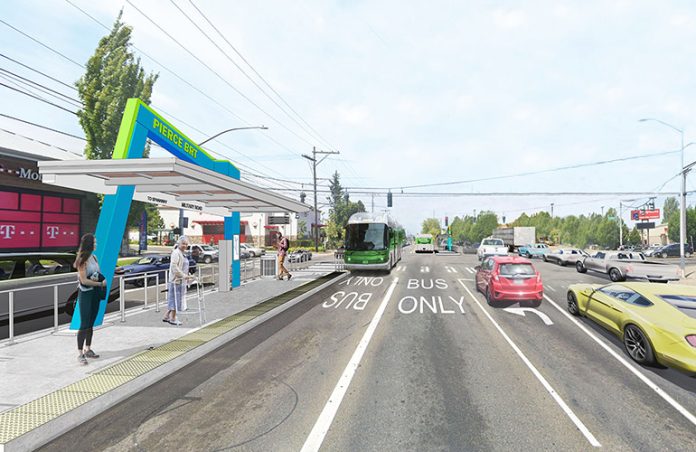
Hopes for the first high-quality Bus Rapid Transit (BRT) line in Pierce County were formally dashed this week when Pierce Transit told its board of commissioners that it could no longer move forward with plans to create any dedicated space for buses along Pacific Avenue between downtown Tacoma and Spanaway.
The line, which was to be run under the branding of “Stream” and would have upgraded Pierce Transit’s most-used route, Route 1, has been in planning for over five years and gone through multiple iterations as the agency tried to find a design that met the approval of both the City of Tacoma and the Washington State Department of Transportation (WSDOT), which would have to sign off on any changes to a significant portion of the corridor that exists as State Route 7.
Pierce Transit will now have to radically rethink how it can deliver more frequent, reliable transit along the corridor, as the latest cost estimates for the current design have been pegged at $311 million, over $100 million more than the agency has identified as potentially available. That funding includes $22 million from the agency itself, $60 million from Sound Transit, and more than $26 million in state transportation funding. But it also includes a potential $75 million grant from the Federal Transit Administration (FTA) that may be at risk if the agency pulls elements from the project that ensured ridership gains.
“We had to go back to the drawing board and reimagine the project, essentially, to bring the cost down $100 million,” Pierce Transit project manager Shawn Robertson told the board. But the agency is facing pushback on the idea of taking out many of the project elements that made the proposed line worthwhile in the first place, with many of the actual impacts on riders still unclear.
Ryan Mello, a Pierce County councilmember who serves on the Pierce Transit board of commissioners, expressed frustration with how things have progressed in a conversation with The Urbanist. “After picking a locally preferred alternative, in July of 2018, here we are in July of 2023, with no firm date to break ground and build this project. We’ve spent millions of dollars in planning and engineering, multiple traffic impact analyses, and we still don’t have certainty of an FTA rating, we do not have certainty of a construction schedule.”
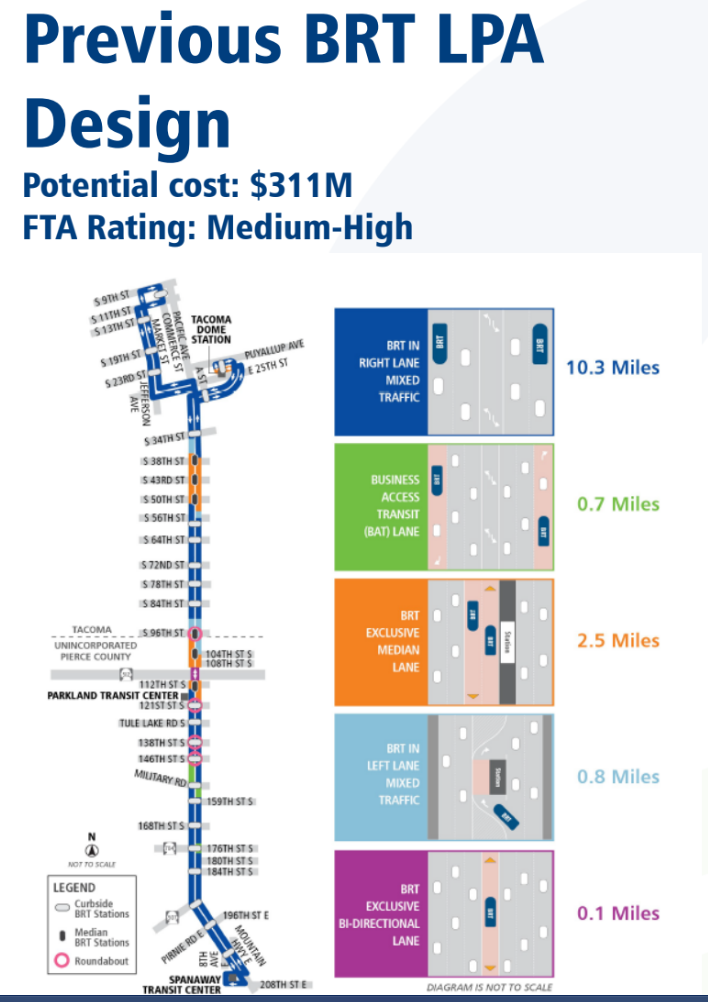
One of the biggest drivers of the project’s high anticipated cost was an incredibly high number of property acquisitions — with over 300 properties along the corridor eyed for full or partial acquisition — that would have been needed to provide space to maintain existing capacity for general purpose traffic and make room for planned stations in the middle of already expansive Pacific Avenue. “Large median stations with a wide project footprint do not fit within the existing constrained corridor footprint,” a slide presented to the board read. But those constraints mostly come from a perceived need to maintain vehicle capacity on the corridor even as the project is ostensibly about enticing riders to choose transit.
The battle over the need for property acquisition to avoid impacts to existing (and future) traffic echoes similar struggles elsewhere in the region, including Sound Transit’s Stride BRT projects, which also face significant budget increases.
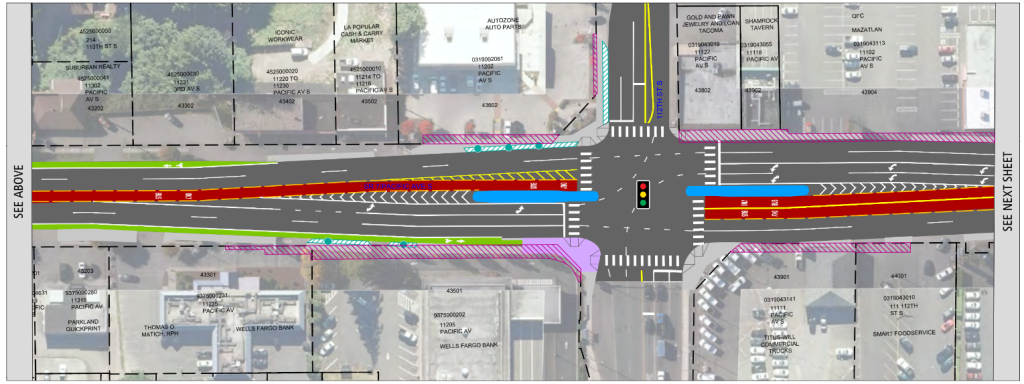
WSDOT pushed for the inclusion of a number of roundabouts in the proposed design to ensure optimal vehicle flow. In the presentation this week, Pierce Transit cited traffic impact analysis work that the agency had to do to come to a consensus with state and local partners, which looked at theoretical vehicle delays in the corridor in 2030 and 2045. But backing away from creating high quality transit in the corridor because of potential traffic in the future is a surefire way to ensure that those projections come to pass.
“We we keep getting into these self-fulfilling prophecies and not prioritizing making transit, convenient, accessible, the preferred option, because it’s highly convenient and accessible,” Mello said. “We are making it less convenient, and not the competitive choice: competitive by time savings, of course, and attractiveness and comfort. We have to do a lot more for it to be the preferred option. And right now, we’re just not hitting the mark.”
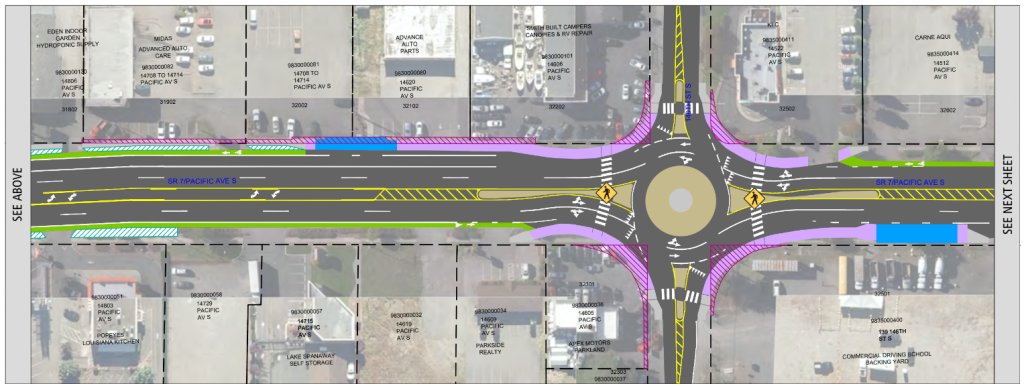
Even though Pierce Transit made a number of concessions in its design to satisfy the demands of other agency partners, the $311 million project still wouldn’t have been ready to move forward even if full funding had been secured.
“Ultimately…we’re still lacking overall agreement with partners on the project footprint and potential mitigation,” Robertson told the board. “This is required for us to know exactly how much this project is going to cost and complete NEPA and SEPA or environmental processes. The current design requires significant agency agreements. We have drafted a majority of those, but we are still looking at a couple of sticking points on some of those agreements. And then we have uncertainty around just the type and nature and cost and extent of mitigations that would have been required.”
The budget already included $20 million that would have been spent cleaning up properties along the corridor that had to be acquired. Pierce Transit, WSDOT, and the City of Tacoma have just not been on the same page when it comes to how a BRT line could be added to Pacific Avenue.
New $187 Million Concept
A more “realistic” BRT concept that could potentially fit within the proposed budget was presented to the board this week as an alternative to the $311 million one now headed to the dustbin. It would include no dedicated space for buses, the same number of consolidated stops compared to the current Route 1 (28), but around half of those stations wouldn’t include amenities like off-board payment. Any roundabouts would be left to WSDOT to fund, and pedestrian improvements that would have been included in the design would be dramatically scaled back.
The new concept would only require around 60 partial property acquisitions, and compared to an opening date of 2028 or 2029, it could be ready to start service by 2027. But $187 million is still a substantial amount of money for a set of improvements that represent a major scaling back of the ambitions of the initial project.
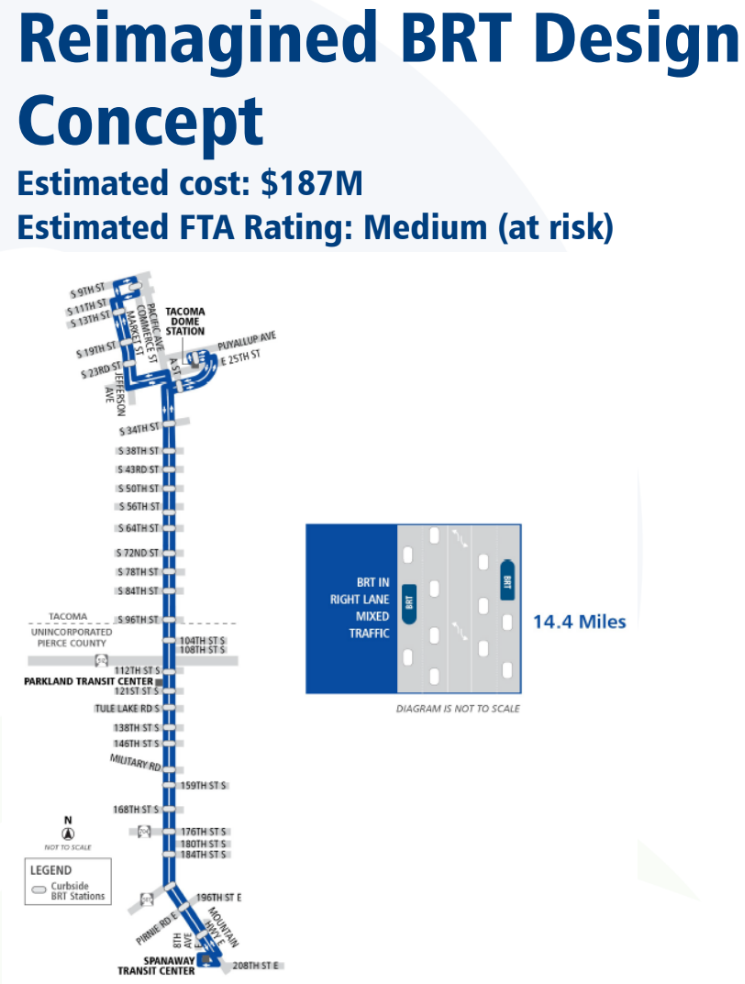
Transit advocates are already expressing skepticism about how well the improved concept could perform.
“We have significant concerns about the proposed reduced scope project and its ability to draw in new riders,” Laura Svancarek, advocacy manager for Downtown on the Go, a transportation advocacy group focused on Tacoma, told the board. “Leaving several stations unimproved creates an inconsistent rider experience…leaving the bus in general purpose traffic cuts time savings for riders dramatically and makes switching to BRT less appealing. This leaves us with concerns about if ridership increases would be enough to offset the carbon costs of the construction of the project.”
Svancarek told the board that this was the time to get the project right. “Whatever is decided that’s it. We can’t change station placement after construction…and we really can’t set a precedent for mixed traffic only BRT as the standard in Pierce County.”
Federal Funds at Risk
By radically changing course on the project, Pierce Transit potentially risks losing the $75 million Federal Transit Administration (FTA) grant that it had been well positioned to receive. The previous design moving forward, which would have included dedicated lanes, had been initially rated in the “medium-high” range by FTA, but the new design is only rated “medium” at this point. To qualify for the FTA Small Starts program, a BRT operating in mixed traffic has to show that service would represent a significant upgrade from the current conditions, a metric that will depend a lot on how many projected riders that Pierce Transit expects to add.
Another hiccup is a recent change at FTA to utilize 2022 ridership numbers, when Pierce Transit’s prior rating for the project had been based around pre-pandemic ridership. Ridership is increasing across the countywide system, but remains well below pre-pandemic highs. If the $75 million grant were to come off the table, BRT in Pierce County would likely be thrown into jeopardy yet again.
Interim Option Moving Forward Before Full BRT
While the agency continues to spin its wheels on a full BRT upgrade, the board was presented with an interim “enhanced bus” concept that could deliver a modest improvement to current riders along the Route 1. It would essentially operate as express bus service, supplementing the existing local route, only running as far north as Tacoma Dome station, not running through downtown Tacoma and with only 13 proposed stops. The agency would only have to upgrade a few shelters, with most of the cost of the improvement coming from additional trips themselves. A 14-minute travel time savings was touted to the board, but that largely comes from skipping stops and running an abbreviated version of the route, with riders heading elsewhere still needing to make up that time.

Moving forward with that option doesn’t preclude Pierce Transit from pursuing full BRT at the same time. “I think the staff is trying to be creative about how to deliver something sooner rather than later,” Mello said. “And I certainly appreciate the creativity, [but] it’s not what the region deserves, and needs to facilitate the growth that continues to come.”
For now, the agency will conduct more analysis that it can present to the board, with a decision point further down the road. Ultimately, Pierce Transit’s yearslong battle to create higher quality transit along Pacific Avenue, in which much of the resistance came from other levels of government, shows how much more work there is to be done to encourage interagency cooperation when it comes to advancing shared goals like increasing transit ridership.
Ryan Packer has been writing for The Urbanist since 2015, and currently reports full-time as Contributing Editor. Their beats are transportation, land use, public space, traffic safety, and obscure community meetings. Packer has also reported for other regional outlets including BikePortland, Seattle Met, and PubliCola. They live in the Capitol Hill neighborhood of Seattle.

